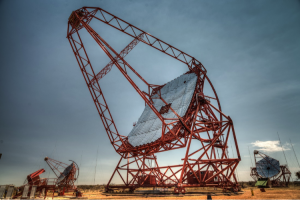Careful analysis of the H.E.S.S. observations showed that very high-energy gamma-ray emission from galaxies with a highly energetic nucleus is not concentrated in the region close to their central black hole but in fact extends over several thousand light-years along jets of plasma. This discovery shakes up current understanding of the maximum energy attainable by the particle acceleration processes.
The full press release from Max-Planck-Institut für Kernphysik can be viewed here.
DIAS is proud of our history of leading international research in Cosmic Ray and High-Energy Astrophysics, and is a founding member of the H.E.S.S. collaboration.
This is the 6th H.E.S.S. paper published in Nature since 2004. The H.E.S.S. project received the Descartes Prize in 2007, a prize given by the EU to honour scientific teams that have achieved outstanding scientific and technological results in trans-national projects. Prof. Aharonian received the 2010 Rossi Prize of the American Astronomical Society, together with Profs. Werner Hofmann and Heinrich Voelk, for outstanding contributions to imaging very-high-energy gamma rays with H.E.S.S.
DIAS astrophysicists Prof. Aharonian, Dr. Mackey, and Dr. Davit Zargaryan are actively working on analysing and interpreting sources of high-energy gamma rays with their international colleagues in the H.E.S.S. collaboration, as well as looking to the next generation of global observatories commencing operations and in planning stages.
This website uses cookies to improve your experience while you navigate through the website. Out of these, the cookies that are categorized as necessary are stored on your browser as they are essential for the working of basic functionalities of the website. We also use third-party cookies that help us analyze and understand how you use this website. These cookies will be stored in your browser only with your consent. You also have the option to opt-out of these cookies. But opting out of some of these cookies may affect your browsing experience.
Necessary cookies are absolutely essential for the website to function properly. This category only includes cookies that ensures basic functionalities and security features of the website. These cookies do not store any personal information.
Any cookies that may not be particularly necessary for the website to function and is used specifically to collect user personal data via analytics, ads, other embedded contents are termed as non-necessary cookies. It is mandatory to procure user consent prior to running these cookies on your website.
H.E.S.S. Collaboration detects gigantic particle accelerator spanning thousands of light years
Leave a Comment
Posted: 25th June 2020 by Caoimhe Mulhall
A new paper by the H.E.S.S. collaboration, including DIAS scientists Prof. Felix Aharonian, Prof. Emeritus Luke Drury and Dr. Jonathan Mackey, is published in the journal Nature on 18th June 2020.
Careful analysis of the H.E.S.S. observations showed that very high-energy gamma-ray emission from galaxies with a highly energetic nucleus is not concentrated in the region close to their central black hole but in fact extends over several thousand light-years along jets of plasma. This discovery shakes up current understanding of the maximum energy attainable by the particle acceleration processes.
The full press release from Max-Planck-Institut für Kernphysik can be viewed here.
The paper is titled “Resolving acceleration to very high energies along the Jet of Centaurus A” and can be accessed here:
DIAS is proud of our history of leading international research in Cosmic Ray and High-Energy Astrophysics, and is a founding member of the H.E.S.S. collaboration.
This is the 6th H.E.S.S. paper published in Nature since 2004. The H.E.S.S. project received the Descartes Prize in 2007, a prize given by the EU to honour scientific teams that have achieved outstanding scientific and technological results in trans-national projects. Prof. Aharonian received the 2010 Rossi Prize of the American Astronomical Society, together with Profs. Werner Hofmann and Heinrich Voelk, for outstanding contributions to imaging very-high-energy gamma rays with H.E.S.S.
project received the Descartes Prize in 2007, a prize given by the EU to honour scientific teams that have achieved outstanding scientific and technological results in trans-national projects. Prof. Aharonian received the 2010 Rossi Prize of the American Astronomical Society, together with Profs. Werner Hofmann and Heinrich Voelk, for outstanding contributions to imaging very-high-energy gamma rays with H.E.S.S.
DIAS astrophysicists Prof. Aharonian, Dr. Mackey, and Dr. Davit Zargaryan are actively working on analysing and interpreting sources of high-energy gamma rays with their international colleagues in the H.E.S.S. collaboration, as well as looking to the next generation of global observatories commencing operations and in planning stages.
Category: Astronomy and Astrophysics, Astronomy and Astrophysics Section News & Events, DIAS, News, Uncategorised
Recent Posts
DIAS Astrophotography competition goes mobile for 2024
Irish scientists are part of groundbreaking discovery with James Webb Space Telescope
Dr Pauline Gagnon (formerly of CERN) to deliver two talks at DIAS
DIAS Professor announced as next President of the European Southern Observatory’s Council
Quake Shake: New programme encourages people to get involved in monitoring earthquakes
Language switcher